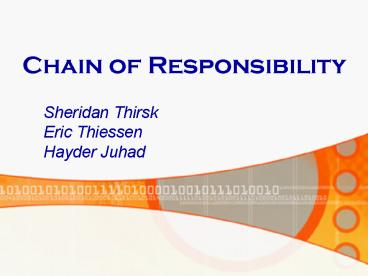Chain of Responsibility - PowerPoint PPT Presentation
1 / 21
Title:
Chain of Responsibility
Description:
Chain of Responsibility. Sheridan Thirsk. Eric Thiessen. Hayder Juhad ... Tarr, Bob. ( 2004). The Chain of Responsibility Pattern - Design Patterns in Java. ... – PowerPoint PPT presentation
Number of Views:590
Avg rating:3.0/5.0
Title: Chain of Responsibility
1
Chain of Responsibility
- Sheridan Thirsk
- Eric Thiessen
- Hayder Juhad
2
Introduction
- Behavioural object design pattern
- Promotes loose coupling
- Chain of handlers
- Only one handler can handle request
- Pass request down the chain
- Sender does not know handler explicitly
3
Action
- Client initiates request
- First object in chain attempts to handle request
- If it can, it does!
- If not, it passes the request to its successor
- Succesor attempts to handle request
- The pattern continues...
4
Participants
- Abstract Handler
- Defines common interface
- Links to successor
- Concrete Handler
- Extends abstract handler
- Each one can handle certain type of request
- Only access its successor
- Client
- Initiate request
- Not known which handler will handle request
5
Class Diagram
- Figure 1 Class Diagram of the Chain of
Responsibility
6
Applicability
- Consider using Chain of Responsibility if
- Multiple possible handlers
- No receiver specified
- Dynamic specification of responsibility
7
Benefits
- Low Coupling
- Object does not know who handler is
- Reduces interaction
- Sender and receiver need not know each other
- Flexibility
- Reorder chain
- Add or remove handlers dynamically
8
Drawbacks
- Cannot guarantee receipt
- Request may get passed along by ALL handlers
- Request falls off the end of the chain
9
Real Example
- Security Monitoring System
- Various sensors
- Hierarchy of information passed up
- Passed up higher until object handles it
- Domain Name Server (DNS)
- Client connect to local DNS
- Server passes request until it is handled
10
Known Uses
- Windows system to handle input
- GUI events
- From object where event occurred to Handler
- Pass events up container hierarchy
- Known as
- Responder in Java 1.0 AWT
- Event-Handler in MacApp
- Bureaucrat in Symantecs TCL library
11
Sample Code
- //Base Class
- class Handler
- protected
- Handler successor
- public
- void SetSuccessor(Handler s)
- virtual void HandleRequest(void r)
12
Sample Code
- //Domain Name Server
- class DNS public Handler
- private
- Char ServerName
- DomainNameEntry DNSTable
- int size
- public
- // Adds a entry in the DNSTable
- void Add(char DomainName, char b1, b2, b3,
b4) - void HandleRequest(char request)
- // if request in DNSTable then return entry
- // otherwise pass request to successor if
// it exists
13
Sample Code
- void main()
- // create servers
- DNS A("Server A")
- DNS B("Server B")
- DNS C("Server C")
- // setup a Chain of Responsibility
- A.SetSuccessor(B)
- B.SetSuccessor(C)
- C.SetSuccessor(NULL)
- //initialize the tables for the servers
- A.Add("google.com",124,32,4,1)
- A.Add("amazon.com",224,132,14,6)
- ...
- C.Add("i-like-puppies.com",12,23,4,114)
14
Sample Code
- //get user request
- char input255
- cout ltlt"Input Request "
- cin gtgt input
- //pass request to server A
- A.HandleRequest(input)
15
Related Patterns
- Composite
- Parent is successor to child
- Parent asks all children to perform operation
- Visitor
- Visitor Handle Request
- Visited cannot pass the request
- Iterator
- Same operation
- Structure is different
- Iterator Sequential chain
- CoR Many possibilities. Linked list, tree, etc.
16
Conclusion
- Its just a chain!
- Each object in chain is potential handler
- Link to next object, successor
- Unknown handler
- Pros
- Reduced coupling
- Increased flexibility
- Con
- Can fall off the end
- Decouple requester and handler
- Especially with multiple handlers
17
Any Questions?
- Well, we have two!
- And we have answers
18
QA 1
- What can be done about requests falling off the
end of the chain?!? - Use a Controller with error handling
- Use exception handling
19
QA 2
- What about an circular chain?!?
- Keep track of chain length
- Count times the request is passed
- If greater than length going in circles
- Error handling, throw an exception, etc.
20
Thank you!
- Check out our website
- http//homepages.ucalgary.ca/sjthirsk/
- Contact us with any additional questions
- Eric
- ethiessen_at_gmail.com
- Sheridan
- sheridan_at_shaw.ca
- Hayder
- hjuhad_at_ucalgary.ca
- Or ask us in person!
21
References
- Cunningham. (2004). Chain of Responsibility
Pattern - Cunningham Cunningham, Inc. July 14,
2004.http//c2.com/cgi/wiki?ChainOfResponsibility
Pattern - (Gamma, Helm, Johnson Vlissides, 1995) E.
Gamma, R.Helm, R.Johnson, J.Vlissides (1995).
Design Patterns. Addison Wesley. ISBN
0.201-63361-2. - Roe, Cameron. (1998). Chain of Responsibility
Design Pattern - SENG 609.04 Winter 1998.
Software Engineering Research Network, University
of Calgary. March 22, 1998.http//sern.ucalgary.c
a/courses/SENG/609.04/W98/roec/Chain/chain.htmlDi
sscussion - Sarma, T. Kulathu. (2001). Chain of
Responsibility - The Code Project. July 11,
2001.http//www.codeproject.com/gen/design/chain_
response.asp - Tarr, Bob. (2004). The Chain of Responsibility
Pattern - Design Patterns in Java. April 15,
2004.http//www.research.umbc.edu/tarr/dp/lectur
es/Chain.pdf - To, Ha. (1999). Chain of Responsibility -
Department of Computer Engineering, Santa Clara
University. February 19, 1999.http//sol.students
.engr.scu.edu/hto1/pattern/ddcor.html































